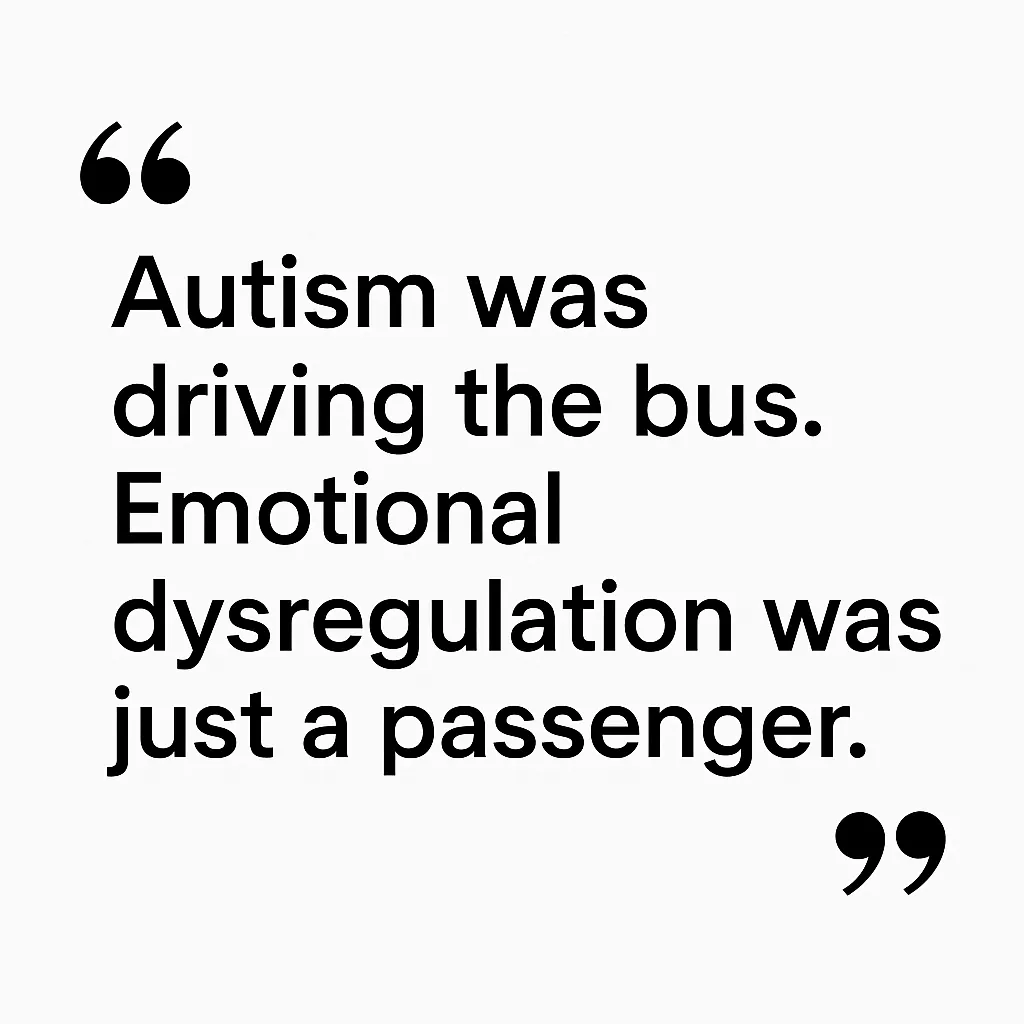
Acting Out or Burning Out? Why Schools Keep Mislabeling Autistic Students with Emotional Disabilities
By Dr. Kristen Eccleston, The NeuroDiverse Teacher
In countless IEP meetings, I’ve observed a recurring pattern affecting two distinct groups of autistic students—and it’s leading to mislabeling, misplaced services, and missed opportunities for real support.
These students are often misunderstood—not due to bad intentions, but because many educators, special educators, and even school psychologists haven’t received the kind of training needed to recognize how autism actually presents, especially in students with ASD Level 1.
Let me break it down.
Group 1: Younger students who “act out.”
These are autistic students with sensory sensitivities, slower processing speeds, and difficulty navigating rapid emotional shifts. They’re overwhelmed—but instead of being supported with wait time, environmental accommodations, or visual processing tools, adults often expect immediate resolution.
A classic example?
An adult insists that the student “talk it out” right after an incident. No calm-down time. No regulation strategy. No buffer. Just direct confrontation when the student is already overstimulated and shutting down.
And then the inevitable happens: the student explodes. They yell. They cry. They throw something. They flee. And in the aftermath, they’re labeled as having an Emotional Disability (ED).
But here’s the problem:
That behavior wasn’t born from defiance or an “emotional disorder.”
It was the natural response of a nervous system in distress.
Autism was driving the bus. Emotional dysregulation was just a passenger.
When we fail to recognize the neurological underpinnings—the need for processing time, predictability, and co-regulation—we set these students up to be misunderstood, punished, or pathologized.
Group 2: Older students who burn out and withdraw.
These are the students who, for years, were praised for being “well-behaved,” “mature,” or “easy.” They masked. They worked hard to comply. They tried to meet neurotypical expectations in environments that never matched their neurotype.
By middle or high school, that mask starts to slip.
These students begin to unravel.
They feel isolated, misunderstood, and increasingly disconnected from peers.
They start missing school.
They stop participating.
They shut down.
They lose a sense of who they are.
And once again, they’re given the same label: Emotional Disability.
But this isn’t just depression. It isn’t just withdrawal.
This is autistic burnout—and it’s what happens when we expect someone to contort their entire identity just to be accepted.
Then, these same students are often placed in counseling or therapeutic settings alongside peers who exhibit more outward, externalizing behaviors—students whose challenges may include aggression, impulsivity, or oppositional defiance.
It’s not that these students don’t benefit from a counseling or therapeutic environment—it’s that they need one tailored to their neurodivergent profiles. They need staff trained specifically in autism, Pathological Demand Avoidance (PDA), and burnout, and they need to be grouped with like-minded peers—those who share a similar emotional and regulatory experience, such as internalizing symptoms like anxiety, depression, or trauma-related withdrawal, even if they aren’t autistic themselves.
When that alignment isn’t there, the environment can unintentionally cause harm.
Instead of support, they get retraumatized.
Instead of connection, they feel more isolated.
And instead of making progress, they shut down even further.
Why This Mislabeling Matters
Mislabeling autistic students as having ED is more than a paperwork problem.
It affects everything:
They don’t get the right supports
Their placements mismatch their actual needs
They’re misunderstood at a developmental level
They internalize the wrong narrative about who they are
And their burnout or dysregulation worsens over time
In short: we’re putting the wrong name on the file—and giving the wrong tools to the child holding it.
The Research Is Clear
This isn’t just about anecdotal experience—it’s backed by peer-reviewed data:
Emotion regulation difficulties in autism are neurologically rooted—not separate or secondary emotional disorders (Mazefsky et al., 2013).
Prolonged masking contributes to exhaustion, burnout, and identity confusion in older students (Hull et al., 2021; Raymaker et al., 2020).
Mislabeling autism as ED prevents students from accessing appropriate supports, and erodes their self-concept and mental health over time (Kapp et al., 2013).
The Path Forward
Until we train IEP teams to see autism as the primary lens through which to interpret these behaviors—especially in ASD Level 1 profiles—we will continue to misclassify, misplace, and miss the mark.
If we keep focusing on what we can see, instead of why it’s happening, we’re going to keep losing these kids.
Stop labeling the meltdown. Start understanding the mind.
References:
Hull, L., Mandy, W., & Petrides, K. V. (2021). Camouflaging in autism: A systematic review. Clinical Psychology Review, 89, 102080. DOI: 10.1016/j.cpr.2021.102080
Kapp, S. K., Gillespie-Lynch, K., Sherman, L. E., & Hutman, T. (2013). Deficit, difference, or both? Autism and neurodiversity. Developmental Psychology, 49(1), 59–71. DOI: 10.1037/a0028353
Mazefsky, C. A., Herrington, J., Siegel, M., Scarpa, A., Maddox, B. B., Scahill, L., & White, S. W. (2013). The role of emotion regulation in autism spectrum disorder. Journal of the American Academy of Child & Adolescent Psychiatry, 52(7), 679–688. DOI: 10.1016/j.jaac.2013.05.006
Raymaker, D. M., Teo, A. R., Steckler, N. A., Lentz, B., Scharer, M., Delos Santos, A., ... & Nicolaidis, C. (2020). “Having all of your internal resources exhausted beyond measure”: Defining autistic burnout. Autism in Adulthood, 2(2), 132–143. DOI: 10.1089/aut.2019.0079
